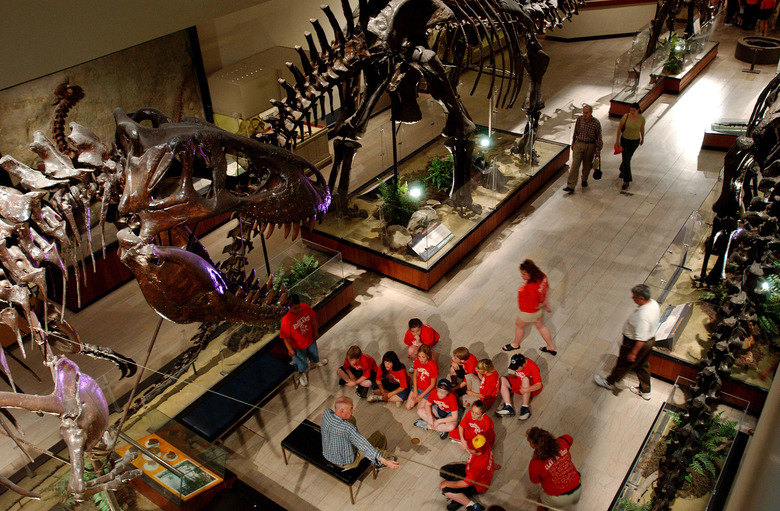What Are The Three Time Periods The Dinosaurs Lived In?
The dinosaurs roamed the earth for more than 150 million years. The Mesozoic Era, lasting from about 252 MYA to 66 MYA, marks the time of the dinosaurs (i.e. archosaurian reptiles). Many other species that still exist in some form today, like conifers and ferns, also found prominence during this geologic period.
TL;DR (Too Long; Didn't Read)
MYA means million years ago, so 100 MYA means something took place 100 million years in the past.
The Permian Extinction
The Permian Extinction
Geologic eras are used to differentiate times of great difference and change in the world. The beginning of the Mesozoic Era followed the end of the Paleozoic Era after the Permian extinction. Over 90 percent of many species of plants and animals were wiped out in this mass extinction event; the Permian extinction is also called "the Great Dying" because it is the most significant extinction event in history.
Paleontologists and geologists are still figuring out the cause of such a dramatic change in Earth's biological makeup, but they can still accurately describe the era and evolution that followed.
Mesozoic Era
Mesozoic Era
The three time periods of the Mesozoic Era are separated by extinction events or geological transformations that caused a significant change in the organic makeup or environmental conditions of the world. The Triassic period, Jurassic period, and Cretaceous period each encompass about 50 to 80 millions years on a geologic time scale. The name Mesozoic means "middle life," as it falls between the Paleozoic era, meaning "old life," and Cenozoic era, meaning "new life." The flora and fauna in the world during this period changed dramatically, with the evolution of dinosaurs and archosaurs (a more general classification for the reptiles of this time that also includes crocodiles and other organisms), more diverse plant life, and the first mammals and birds.
Triassic Period – 252 MYA to 201 MYA
Triassic Period – 252 MYA to 201 MYA
The Triassic period began with the Permian-Triassic extinction. With less than ten percent of many groups persisting, the species that did survive repopulated the Earth and evolved into completely new creatures. The oceans were packed full of life: mollusks, ammonites and the first corals living alongside massive Ichthyosaurs and Plesiosaurs. Pterosaurs, a group of flying reptiles, dominated the air and the first large mammals and dinosaurs roamed the earth. One of the first dinosaurs was the Coelophysis, a carnivore which grew up to 9 feet tall and weighed up to 100 pounds.
This period also marks the beginning of separation for the supercontinent Pangaea, as the plates and continents began to pull apart and resemble the land masses we see today. The Triassic period was separated into the Early, Middle and Late Triassic epochs. The Late Triassic transitioned into the Jurassic period with the advent of the Triassic-Jurassic extinction.
Jurassic Period – 201 MYA to 145 MYA
Jurassic Period – 201 MYA to 145 MYA
The dinosaurs that survived the mass extinction at the end of the Triassic period went on to dominate the Jurassic period. The supercontinent Pangaea which had dominated the Triassic period was rapidly breaking up, and mountains rising up from the ocean floor pushed sea levels up. This made the previously hot and dry climate fairly humid, and prompted the growth of many more plants and trees such as palms and ferns.
The dinosaurs in this period were huge, with the Brachiosaurus standing at 85 feet long, 52 feet tall and weighing 80 tons. Sauropods (like Diplodocus and Apatosaurus), theropods (like Megalosaurus), and other dinosaurs (like Stegosaurus) dominated during the Jurassic period. The massive herbivores during this time were matched with equally large carnivores, such as Allosaurus. The earliest known bird, Archaeopteryx, also originated from the Jurassic period.
The late Jurassic period transitioned into the Cretaceous period following drastic geologic change. This brought about ecological and environmental upheaval which drove evolution of further flora and fauna.
Cretaceous Period – 145 MYA to 66 MYA
Cretaceous Period – 145 MYA to 66 MYA
The Cretaceous period stretched from 146 to 65 million years ago, and by the end of this period, the landmasses were in much the same position as they are today. Throughout this period the continents had been moving further apart; this and the increasing expanses of ocean caused the climate to become more moist and cool. Herds of Iguanodon and Triceratops roamed the globe with Velociraptors and other carnivorous dinosaurs. The famous Tyrannosaurus Rex terrorized the northern hemisphere while Spinosaurus dominated in the south.
The Cretaceous period was only separated into the Early Cretaceous and Late Cretaceous because of the longevity of many species during this time. Flowering plants started to dominate, and some of the largest dinosaurs began a long reign across the world. The world also began to resemble the distinct continents we see today with Australia, South America, North America, and Antarctica all taking on separate forms.
Mammals became larger and more abundant while more species of birds were competing with the flying reptiles for the skies. At the end of the Cretaceous period, the dinosaurs were wiped out by another mass extinction event (consisting of volcanic eruptions, climatic upheaval, and rapid natural disasters), and life on Earth started down a brand new path.
Cite This Article
MLA
Mitchell, Stacey. "What Are The Three Time Periods The Dinosaurs Lived In?" sciencing.com, https://www.sciencing.com/three-time-periods-dinosaurs-lived-8737410/. 24 May 2023.
APA
Mitchell, Stacey. (2023, May 24). What Are The Three Time Periods The Dinosaurs Lived In?. sciencing.com. Retrieved from https://www.sciencing.com/three-time-periods-dinosaurs-lived-8737410/
Chicago
Mitchell, Stacey. What Are The Three Time Periods The Dinosaurs Lived In? last modified May 24, 2023. https://www.sciencing.com/three-time-periods-dinosaurs-lived-8737410/
